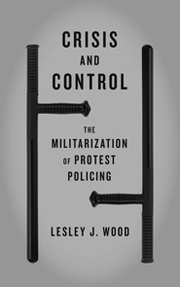BOOK REVIEW: Crisis and Control

 Six Theses on Movement-Building and the Militarization of Policing Crisis and Control
Six Theses on Movement-Building and the Militarization of Policing Crisis and Control
by Lesley Wood
Pluto Press, 2014
Reviewed by Irina Ceric
Having had front row seats during its rise, long-time activists and organizers will immediately recognize the core preoccupation of Lesley Wood’s new book: the militarization of protest policing. Wood seeks to explain the incorporation of less-lethal weapons, pre-emptive arrests and the use of barricades and riot control units in the US and Canada and to locate such shifts in policing tactics within a broad political context, ultimately arguing that policing of dissent “must be understood as a result of a neoliberal transformation of political, social and economic systems, and their effect on police organizations and decision-making”. While Crisis and Control succeeds in both detailing evolutions in protest policing over the last two decades and developing a suitably complex analysis of that process, it is most useful as a work of movement praxis, a rigorous and finely researched examination of global trends in policing and their resulting impact on possibilities for movement-building. At the risk of grossly oversimplifying Wood’s text, I’d like to highlight six lessons about policing, politics and organizing explored in Crisis and Control.
1. KNOW YOUR ENEMY
A key concept referred to throughout Crisis and Control is “strategic incapacitation”, a policing approach meant to pre- empt and contain public protest through the “escalation of coercive policing strategies, incoherent negotiation, generalized and indiscriminate information gathering, and intelligence-led and proactive policing” (3-4). Wood traces the rise of this method in four major cities (Montreal, New York City, Washington, DC and Toronto), highlighting the importance of local political frameworks of accountability and oversight, demonstrating over and over again the myriad ways in which police departments defend their autonomy, legitimacy and resources (budget and police strength). She argues that crises of police legitimacy trigger changes in practices, tool and training, for better or worse (as exemplified by the introduction of Tasers to police forces across the US and Canada). But just as our movements are global, so are police networks, and Wood also reveals how the “thin blue line” has become stronger and more international, with the spread of military technologies as ‘best practices’ offering just one example.
2. KNOW YOUR ALLIES
Reading Crisis and Control underscores the absolute necessity of considering police tactics and strategy as crucial component of mass movement building within a framework of diversity of (our own) tactics – and strategies. Whether we organize against war or for workers’ rights, we must recognize that “the logic of the strategic incapacitation model is a transparent mode of social control” (164), and that protest policing reveals the brutality of the day-to-day ‘criminal justice’ system. When we challenge our own ‘strategic incapacitation’, we can also seize the opportunity to build relationships with communities impacted by police brutality, profiling, etc on a daily basis.
3. SEATTLE WAS A ONE-OFF
The now-apocryphal resistance to the 1999 WTO ministerial was a watershed for radical movements in North America yet the ‘next Seattle’ has evaded us for 15 years. Wood’s analysis makes it clear that waves of protest drive parallel changes in police repertoire (tools, training, techniques, etc), consolidating newfound expertise across police networks.
4. IT DOESN’T MATTER WHETHER THE POLICE ARE THE 99% Wood devotes a fair amount of space to connecting changes in policing to broader evolutions in the function of the state, both historically and in the context of contemporary neoliberalism. Concluding that “processes of wealth extraction and capitalization must be incorporated into any explanation of police strategy”, she succeeds in underscoring, yet again, the complexity of the police as an institution with an international, as well as local, role in maintaining existing structures of political and economic power. (12)
5. ACADEMICS AND ACTIVISTS CAN – AND SHOULD –
PLAY WELL TOGETHER
Crisis and Control would not have been written (or at least, written as well), if the author wasn’t both a sociology professor and a long time activist and organizer. Wood’s ability to historicize and analyze our everyday experiences as protesters and to explain our ‘common sense’ understanding of the changes in policing we’ve witnessed first-hand, is a crucial example of how engaged academics and more broadly, insurgent/militant research methods, can expand our movement praxis.
6. HAVE COURAGE
Reading this book leaves one humbled by the prospect of challenging “not simply a particular technology or practice, but … the legitimacy of both the policing ‘experts’ and their supporters, and the policing logics of controlling populations as a whole.” (167-8) But Crisis and Control also highlights successful attempts to do just that, and makes it clear that we do resist the militarization of protest policing every time we return to the streets with new tactics, stronger coalitions, and creative approaches to movement defense (and legal offense). We’ve changed policing. Let’s keep up the fight.
